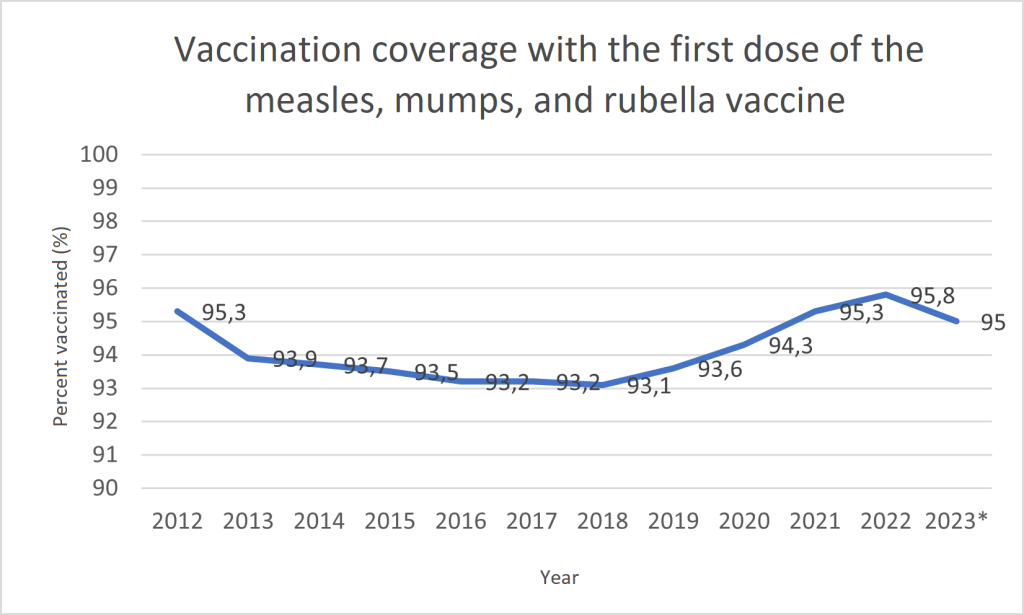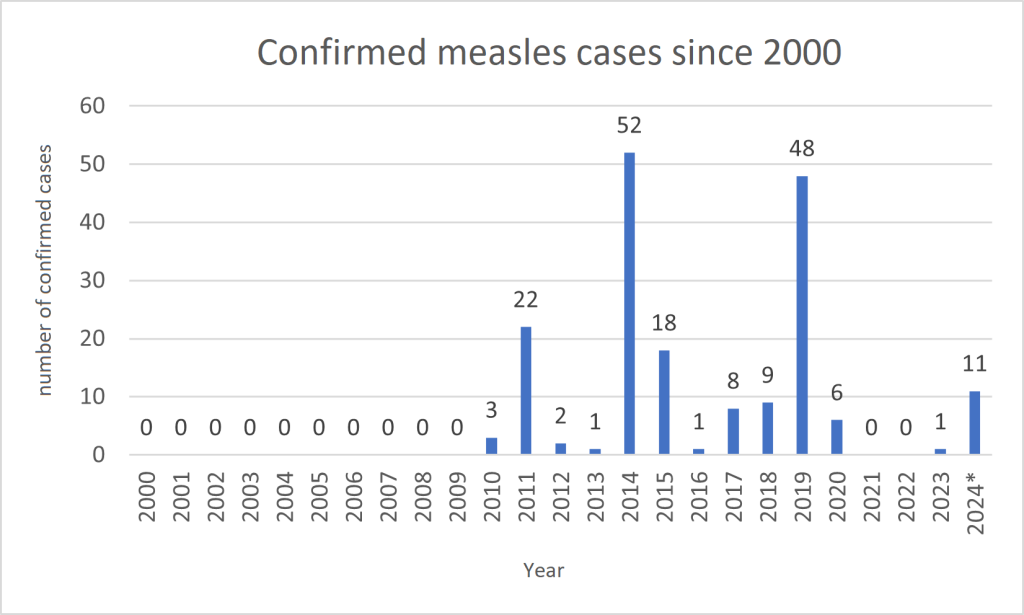Two measles cases in May, 11 in total this year
This year, 11 cases of measles have been confirmed in Slovenia, including two cases in May. Both cases involved unvaccinated children or adolescents.
This year, 11 cases of measles have been confirmed in Slovenia, including two cases in May. Both cases involved unvaccinated children or adolescents.
In May 2024, measles was confirmed in a 7-year-old child from the Celje region and a 15-year-old adolescent from the Ljubljana region. Neither of them had been vaccinated. A total of 58 contacts were identified.
For contacts, the response algorithm involves checking their vaccination status or susceptibility to measles infection. Vaccination of susceptible contacts or protection with immunoglobulins (in severely immunocompromised patients, infants and pregnant women) is required.
Contacts who develop measles-like symptoms should stay at home and consult their doctor by telephone for further action.
Vaccination is crucial to limiting the spread of infection and preventing disease, so it is of the utmost importance that children receive all the vaccinations they are entitled to in accordance with the vaccination schedule. Two doses of vaccine are needed for protection.

*preliminary data
The disease is transmitted directly or indirectly by infectious droplets from the nose and throat secretions of an infected person (sneezing, coughing). A person with measles is contagious about four days before the rash appears and remains contagious for four days after the rash appears. The disease spreads most rapidly in environments such as kindergartens, schools, and mass events. Individuals who recover from measles are permanently protected against the disease.
The highest risk for complications and death is among infants and immunocompromised individuals. Complications occur in about 30 percent of cases. The disease can cause severe diarrhoea with dehydration in new-borns and infants. In children, complications such as otitis media or pneumonia, which is the most common cause of death, can occur. Less commonly, inflammation of the central nervous system can develop as a complication.
It takes about 10 days from infection to first symptoms, which can be 7 to 18 days. The onset is sudden, with high fever, severe headache, fatigue, runny nose, conjunctivitis and cough. This is followed by the appearance of a rash in the mouth on the soft palate, tongue, palate. On the second and third day of the disease, the characteristic ‘Koplik spots’ appear, which are small white spots found on the mucous membranes opposite the molars. On the 14th day after infection, a rash appears on the skin that lasts up to seven days. Patients are severely ill and have a high fever when the rash forms.
Only supportive care is available, and the patient must rest and drink enough fluids to prevent dehydration. Antibiotics are only needed for bacterial complications of measles (otitis media, pneumonia, etc.).
Measles vaccination started in Slovenia in 1968. The incidence of the disease has decreased significantly since then. In 1974, measles revaccination was introduced in the vaccination programme for children aged 4 or 5 years who had already been vaccinated once. Thus, persons born in 1969 and later generally received two doses of measles vaccine.
Since the introduction of vaccination, the incidence of measles has been consistently declining, except in the years 1973, 1976/1977, 1984 and 1994/1995, when transient epidemic spikes were observed again. In recent decades, the incidence of measles in Slovenia has been very low, with no cases reported from 2000 to 2009.

* until 20 May 2024
Measles has been on the rise again in several European countries in the last year, and individual cases are expected in Slovenia as well. We would like to take this opportunity to ask healthcare professionals to be alert to possible symptoms and signs of measles when treating their patients: fever (38°C), maculopapular skin rash, cough, runny nose, conjunctivitis.
Potential patients should be treated according to the measles management algorithm. Any suspicion of measles must be immediately reported to the regional epidemiologist.
Proper management of suspected cases and appropriate treatment of the ill person are important contributors to preventing further spread of the disease.